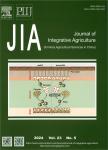An Evaluation of the Infection Status and Source of Subgroup J Avian Leukosis Virus in Cloned Free-Range Layers
An Evaluation of the Infection Status and Source of Subgroup J Avian Leukosis Virus in Cloned Free-Range Layers作者机构:College of Veterinary Medicine Shandong Agricultural University Lanzhou Veterinary Research Institute Chinese Academy of Agricultural Sciences
出 版 物:《Journal of Integrative Agriculture》 (农业科学学报(英文版))
年 卷 期:2013年第12卷第4期
页 面:687-693页
核心收录:
学科分类:090603[农学-临床兽医学] 09[农学] 0906[农学-兽医学]
基 金:the Biology post-Doctoral Stations at the Shandong Agricultural University China
主 题:cloned free-range layers ALV-J infection status hereditary variation source exploration
摘 要:In recent years, subgroup J avian leukosis virus (ALV-J) has been found to frequently infect layers in China. This virus is responsible for economic losses due to both mortality and decreased performance in chickens. In this study, 45-d-old cloned flee-range layers were suspected to be infected with ALV and other immunosuppressive diseases because their feathers were unkempt and their growth rate was impaired. To estimate the infection status and determine the source of ALV-J in the flock, 30 cloacal swabs were randomly collected to measure the p27 antigen level by enzyme-linked immunosorbent assay (ELISA). Among the birds that were tested, 87% (26/30) were positive. In addition, 6 anticoagulant blood samples were aseptically collected at random from the flock when the layers were 60 d old. These samples were centrifuged to obtain the leukocytes, which were then used to inoculate chicken embryo fibroblast (CEF) cells for the identification of ALV-J by indirect immunofluorescence (IFA). Of the samples tested, 100% (6/6) were positive. The flock's production performance was also investigated, and 10 layers were necropsied to evaluate pathological changes at 115 d of age. The flock never laid eggs even though they reached the age of the first laying (110 d). Furthermore, there were pathological changes present, including atrophy of the thymus and bursa of Fabricius, undeveloped ovaries, glandular stomach haemorrhage, and hepatosplenomegaly. Paraffin-embedded sections of intumescent liver and spleen were prepared for antigen localisation using IFA. Positive signals were prevalent in paraffin-embedded sections of the intumescent liver and spleen. Furthermore, provirus DNA was extracted from 4 cloned flee-range layers, and 2 patemal parents (HR native cocks), and the gp85 gene of ALV-J was amplified by PCR to analyse the genetic variation. The results of the autogenous variation analysis showed that the 6 strains were 98.5-99.7% homologous. This study indicated that there



